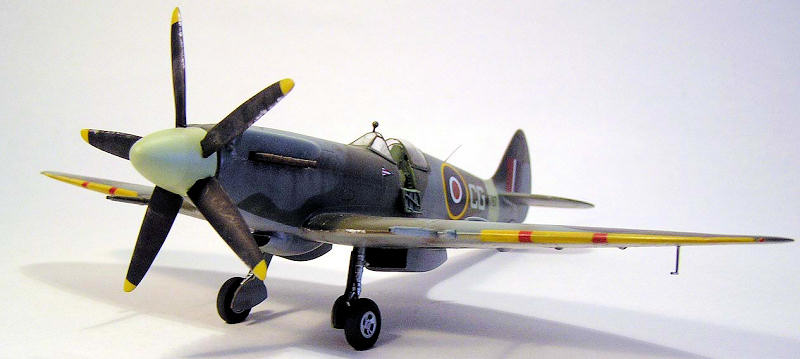
Academy 1/48 Spitfire XIV
| KIT #: | 2161 |
| PRICE: | $18.75 |
| DECALS: | Several options |
| REVIEWER: | Fernando Rolandelli |
| NOTES: |
Academy’s
grossly inaccurate fuselage needs replacement if you are so inclined;
otherwise, builds up nice. |

| HISTORY |
Supermarine Spitfire
F Mk XIVc, RM787, Wing Commander Colin Gray, Lympne, September/October 1944.
The Spitfire F.XIV
was the result of mating the fuselage of the Mk VIII and the two speed,
two-stage supercharged Griffon 61 or 65 at 2.050 hp, driving a five-blade
propeller. It weighed 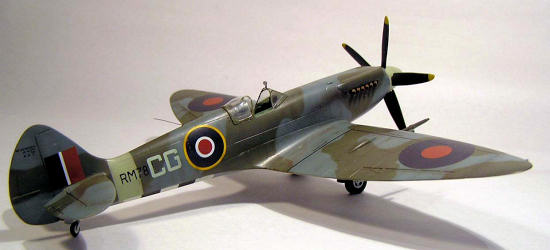 increased
thirst of the Griffon. The throttle was also modified, increasing the arc of
movement, vertical tail surface was bigger and the radiator ducts were widened
(both had a radiator element, complemented by an intercooler under the starboard
and the oil cooler under the port wing). First seria had a “c” armament of two
increased
thirst of the Griffon. The throttle was also modified, increasing the arc of
movement, vertical tail surface was bigger and the radiator ducts were widened
(both had a radiator element, complemented by an intercooler under the starboard
and the oil cooler under the port wing). First seria had a “c” armament of two
Though it was seen as
an “interim” version, pending development of the “definitive” F.21, the F.XIV
was certainly one of the finest air-superiority fighters of the day, easily
surpassing the Bf 109G and Fw 190A, having an overall advantage over the Mk IX
and complementing perfectly the Tempest.
One of twin New
Zealander brothers entering the RAF in 1937 as officer pilots, Colin Gray
survived the war to publish, in 1990, “Spitfire Patrol”, as his autobiography.
An ace credited by
| THE KIT |
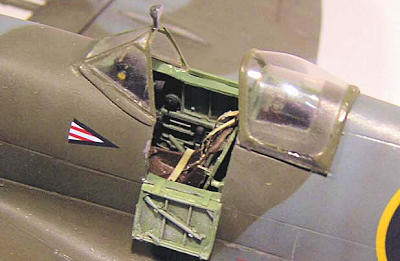 -
The base of the kit
is the excellent Aeroclub Spitfire F.21 fuselage, mated to the wings as well as
the small pieces in the Academy FR Mk XIVe. Aeroclub radiators were used, as
Academy’s are misshapen.
-
The base of the kit
is the excellent Aeroclub Spitfire F.21 fuselage, mated to the wings as well as
the small pieces in the Academy FR Mk XIVe. Aeroclub radiators were used, as
Academy’s are misshapen.
-
Interior was provided
by an Aires set for the Spit Mk IX.
-
Canopy is an Aeroclub
vacuformed.
-
Paints are Xtracolors
through and through
- Specific decals (serials and codes) were taken from Superscale sheet no., while roundels were sourced from Eagle Strike generic sheets.
| CONSTRUCTION |
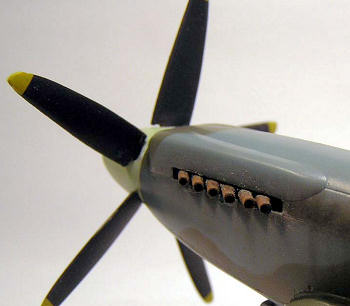 Though
hardly a non-eventful assembly, the Aeroclub fuselage and Academy wings can be
mated without undue trouble; in fact, they assemble better than many kits! The
Aires cockpit needed some coercion, and the fuselage halves to be thinned with a
Dremel, but the results are worth of the effort. You cannot use the excellent
Eduard Spit XIV PE set “as is”, because, made for the Academy fuselage, it is
way too deep for the Aeroclub’s, though of course you could adapt it. The single
canopy included in the conversion set is like smallish, and having a spare
always reassuring, so I used another, an Aeroclub vac made for the Spit IX; a
lot of cleaning up of the cockpit lips has to be made. I also used the “round”
exhausts stacks present in Hasegawa’s Spit IX kits, duly hollowed out; I glued
them after painting, providing a plastic sheet backing in the inside of the
fuselage. Propeller is a hair-raising affair: you cannot glue the blades to the
backplate and then glue the spinner. You have to first glue spinner and
backplate and later carefully glue the blades, keeping the incidence angle by
eyeball. Nope, the Quickboost prop (which includes a clever jig for assembly)
cannot be used: it is mated to the Academy fuselage.
Though
hardly a non-eventful assembly, the Aeroclub fuselage and Academy wings can be
mated without undue trouble; in fact, they assemble better than many kits! The
Aires cockpit needed some coercion, and the fuselage halves to be thinned with a
Dremel, but the results are worth of the effort. You cannot use the excellent
Eduard Spit XIV PE set “as is”, because, made for the Academy fuselage, it is
way too deep for the Aeroclub’s, though of course you could adapt it. The single
canopy included in the conversion set is like smallish, and having a spare
always reassuring, so I used another, an Aeroclub vac made for the Spit IX; a
lot of cleaning up of the cockpit lips has to be made. I also used the “round”
exhausts stacks present in Hasegawa’s Spit IX kits, duly hollowed out; I glued
them after painting, providing a plastic sheet backing in the inside of the
fuselage. Propeller is a hair-raising affair: you cannot glue the blades to the
backplate and then glue the spinner. You have to first glue spinner and
backplate and later carefully glue the blades, keeping the incidence angle by
eyeball. Nope, the Quickboost prop (which includes a clever jig for assembly)
cannot be used: it is mated to the Academy fuselage.
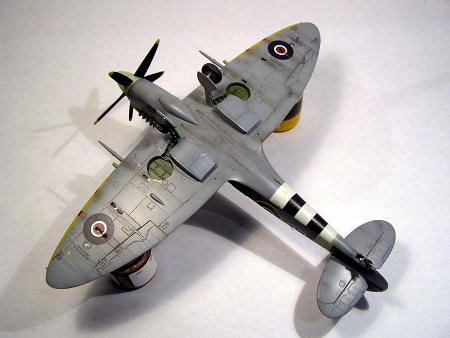 The
usual R/T inspection door, present on the left side of the fuselage, should be
erased and replaced by a similar one on the right side. The fuselage surface was
cleaned up and polished.
The
usual R/T inspection door, present on the left side of the fuselage, should be
erased and replaced by a similar one on the right side. The fuselage surface was
cleaned up and polished.
Compared to that, the
wings were a breeze, even considering the replacing of the radiators. The mounts
of the Academy radiator housings was severed and glued to the recesses on the
wings. Then, the Aeroclub housings were glued in position. Ah, the Aeroclub
radiator faces were adapted to the smaller baths in the Academy wing. This wing
has been criticized as inaccurate, especially in profile, as well as in surface
detail. Certainly, it seems a bit thin in profile, wheel wells are a bit shallow
(a problem common to many kits) and it lacks some surface detail, like the
proper underwing little bulges (in this model they were made from Parsecs
epoxy), but IMHO it fills the bill. It has to be said that Hasegawa’s Spit IX’s
is much better, though, and using it should improve the looks of the final
model. But in this way you can use at least part of the Academy kits you bought
in that overly optimistic mood!
| COLORS & MARKINGS |
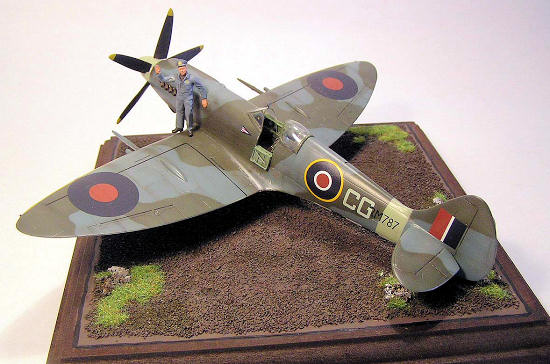 Interior
parts were painted in Interior Grey-Green, from the Xtracolor range. Though
later Spit cockpits were painted Black, there is no indication than this one,
being an early series XIV, had anything else.
Interior
parts were painted in Interior Grey-Green, from the Xtracolor range. Though
later Spit cockpits were painted Black, there is no indication than this one,
being an early series XIV, had anything else.
A standard Day
Fighter Scheme machine, the exterior was painted in DG/OG/MSG, also from the
Xtracolor range. The Sky band and the remnants of the invasion bands were
painted first and masked (the Black in the latter was mixed with a bit of Sand,
for scale effect). Weathering was achieved by the combination of extensive
preshading, lighter postshading and some stains by oils washes and airbrushing a
dark concoction. I went relatively light on this, for the model represents a
Wing Commander’s mount, usually clean and polished.
Gloss varnish coats
were applied in preparations for decals. After these, I use to even out the
shines with an acrylic gloss coat, which has the benefit of being impervious to
oils and washes. Subsequent acrylic flat varnish coats were mixed with an
artist’s flattening fluid, which, if pushed enough, renders a truly dead flat
look. Not on this model, for much the same reasons as above.
Decals were sourced from generic Eagle Strike roundel sheets, while the codes and serials came from an old Superscale sheet. Both performed flawlessly.
| CONCLUSIONS |
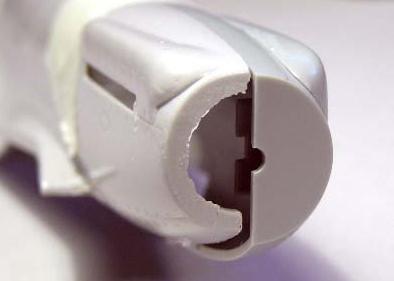 An
aircraft both handsome and powerful-looking, it is a shame that the modeler has
to make such a mix-n-match of different items to get an acceptably accurate
model. Academy kit is really hopeless: it builds up fine, but looks nothing like
the original. Some pictures of the Aeroclub and Academy fuselages put together
are included to further illustrate the futility of undertaking any correction
work on the later by itself. On the other side, the look of the Aeroclub pieces
is very crude and possibly frightening, but the results are worth the pain.
An
aircraft both handsome and powerful-looking, it is a shame that the modeler has
to make such a mix-n-match of different items to get an acceptably accurate
model. Academy kit is really hopeless: it builds up fine, but looks nothing like
the original. Some pictures of the Aeroclub and Academy fuselages put together
are included to further illustrate the futility of undertaking any correction
work on the later by itself. On the other side, the look of the Aeroclub pieces
is very crude and possibly frightening, but the results are worth the pain.
| REFERENCES |
-
“Supermarine
Spitfire: the Griffon powered variants”, SAM Publications.
-
“Spitfire at War”,
Ian Allan.
- “Combat Legend: Spitfire Mk. VI- F.24”, Peter Caygill, Crowood Publications
November 2010
Copyright ModelingMadness.com. All rights reserved. No reproduction in any form without express permission from the editor.
If you would like your product reviewed fairly and quickly, please contact the editor or see other details in the Note to Contributors.